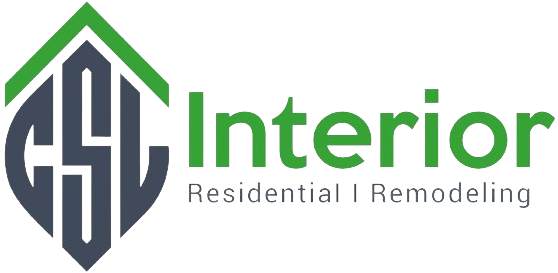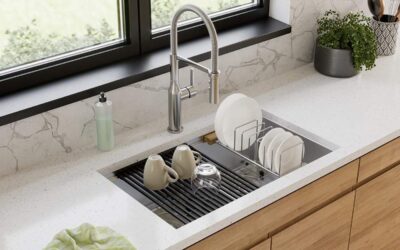Choosing the right flooring for your kitchen is one of the most critical decisions in a remodel. The kitchen is the heart of the home, a high-traffic area where durability, functionality, and aesthetics are essential. With so many flooring options available, finding the perfect one can feel overwhelming. In this guide, we’ll explore four popular kitchen flooring options: tile, hardwood, laminate, and luxury vinyl. By the end, you’ll have the information you need to make an informed choice.
Tile Flooring: Timeless and Durable

Pros:
- Durability: Tile is one of the most durable flooring materials, standing up well to heavy foot traffic, spills, and scratches.
- Water Resistance: Perfect for kitchens, tiles are impervious to water when properly installed and sealed.
- Design Options: Available in countless colors, patterns, and sizes, tile offers endless customization possibilities.
- Low Maintenance: Tiles are easy to clean with a mop or sponge, and they resist stains.
Cons:
- Cold Underfoot: Tile can feel cold, which might not be ideal for colder climates unless paired with radiant heating.
- Hard Surface: Standing for long periods on tile can be uncomfortable.
- Grout Maintenance: Over time, grout lines can become discolored and require regular cleaning or sealing.
Best For: Homeowners looking for a durable, water-resistant, and customizable flooring option.
Hardwood Flooring: Classic and Warm
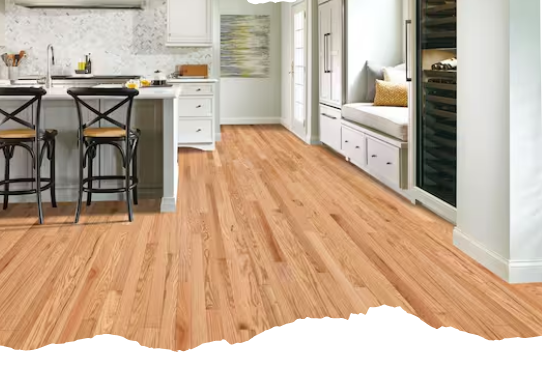
Pros:
- Timeless Appeal: Hardwood adds warmth, elegance, and a sense of luxury to any kitchen.
- Longevity: With proper care, hardwood flooring can last for decades.
- Versatility: Available in various wood species, stains, and finishes to match your style.
- Resale Value: Hardwood is highly desirable and can increase the value of your home.
Cons:
- Susceptible to Water Damage: Wood can warp or stain if exposed to moisture for prolonged periods.
- Maintenance: Requires regular sealing or refinishing to maintain its appearance.
- Cost: One of the more expensive flooring options.
Best For: Those who want a timeless, high-end look and are willing to invest in maintenance to preserve their floors.
Laminate Flooring: Affordable and Stylish
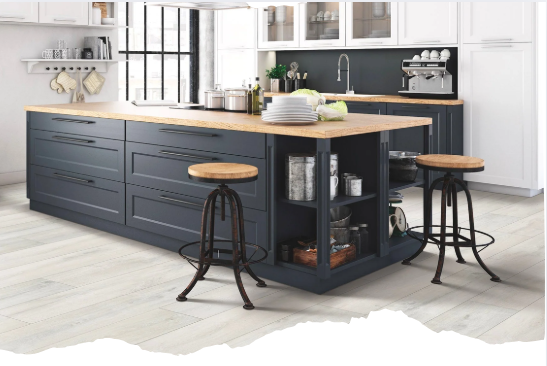
Pros:
- Budget-Friendly: Laminate is typically less expensive than hardwood or tile.
- Wide Variety: Can mimic the look of wood, stone, or tile at a fraction of the cost.
- Easy Installation: Many laminate options come with click-and-lock systems for DIY installation.
- Durability: Resistant to scratches, dents, and general wear and tear.
Cons:
- Moisture Sensitivity: Prolonged exposure to water can cause laminate to warp or swell.
- Feels Artificial: Some homeowners feel it lacks the authentic look and feel of wood or tile.
- Shorter Lifespan: Doesn’t last as long as hardwood or tile.
Best For: Budget-conscious homeowners seeking a stylish and durable alternative to hardwood.
Luxury Vinyl Flooring: Versatile and Resilient
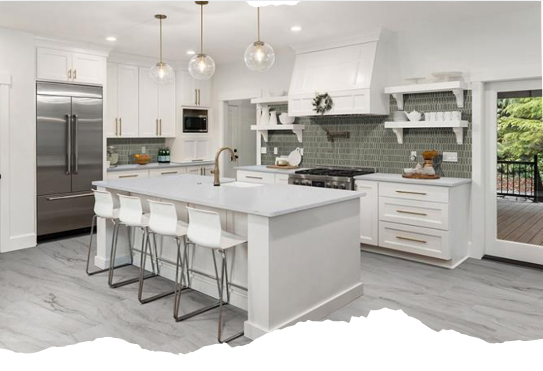
Pros:
- Waterproof: Perfect for kitchens, luxury vinyl can handle spills and moisture without damage.
- Comfortable Underfoot: Softer and warmer than tile or hardwood, making it more comfortable to stand on.
- Durability: Resists scratches, dents, and stains.
- Realistic Designs: Advances in technology allow luxury vinyl to closely mimic the look of wood or stone.
- Easy Maintenance: Simple to clean with a broom or mop.
Cons:
- Environmental Concerns: Vinyl is not the most eco-friendly option and may off-gas volatile organic compounds (VOCs).
- Can Dent: While durable, it can dent under heavy furniture or appliances.
- Not as Premium: Doesn’t add as much resale value as hardwood.
Best For: Homeowners who need a waterproof, low-maintenance option with the look of wood or tile.
Factors to Consider When Choosing Kitchen Flooring
- Durability: Choose a flooring material that can withstand heavy foot traffic and daily wear and tear.
- Water Resistance: Kitchens are prone to spills, so water resistance is essential.
- Style: Consider the overall design of your kitchen and how the flooring complements it.
- Comfort: If you spend a lot of time standing in the kitchen, consider options with a softer feel underfoot.
- Budget: Keep in mind both the initial cost and long-term maintenance expenses.
- Maintenance: Think about how much time you’re willing to spend cleaning and maintaining your floors.
Final Thoughts
Your kitchen flooring is a long-term investment, so it’s worth taking the time to weigh your options. Tile, hardwood, laminate, and luxury vinyl all have their unique advantages and drawbacks. The best choice depends on your lifestyle, design preferences, and budget. Whether you’re drawn to the timeless elegance of hardwood, the practicality of tile, the affordability of laminate, or the versatility of luxury vinyl, you’re sure to find a flooring solution that transforms your kitchen into a beautiful and functional space.
